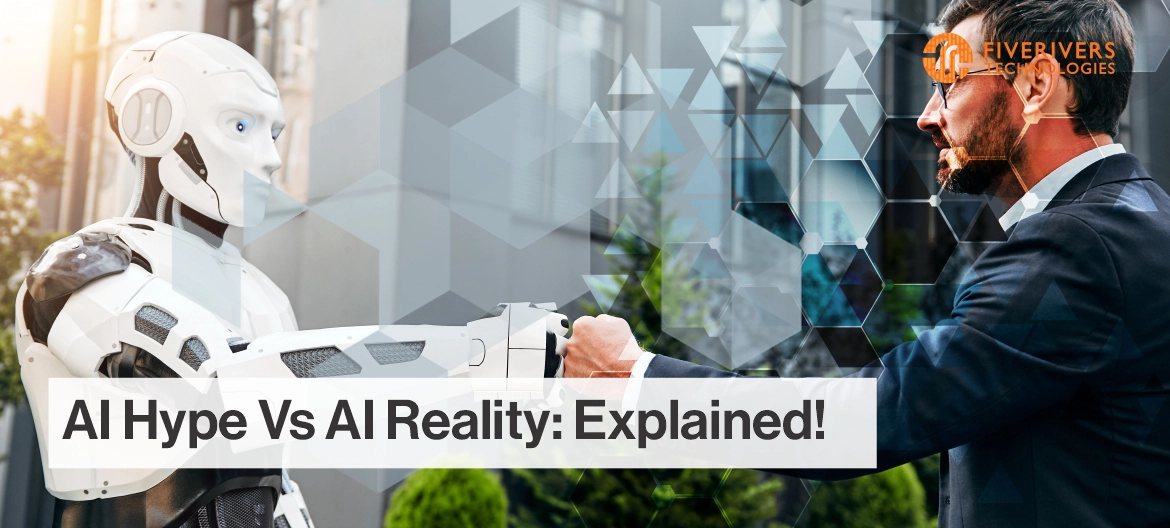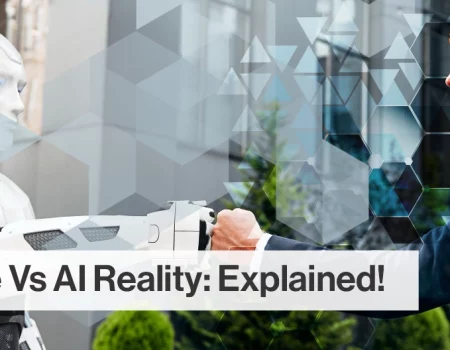Artificial intelligence is quickly becoming a critical part of our lives. From sophisticated algorithms driving recommendation systems to voice-activated assistants in our smartphones, it’s simple to get carried away by the hype around this game-changing technology. A recent survey found that more than 80% of consumers think they often interact with AI, underscoring the widespread use of AI in modern society.
But despite all the buzz and enthusiasm, there is a noticeable disconnect between how artificial intelligence is viewed in popular culture and how it is really used in the real world. The reality is significantly more complex than Hollywood’s portrayal, which frequently presents AI as sentient entities capable of human-like emotions and behaviors.
This article aims to bridge the gap between the sensationalized promises of AI and its actual capabilities, providing readers with a clear understanding of the technology’s true potential. Essentially, explaining the ever-important argument of AI hype vs Reality.
At its core, AI hype stems from exaggerated claims and misconceptions propagated by media portrayals and marketing strategies. From the fear of job displacement to the anticipation of a dystopian future dominated by intelligent machines, the narrative surrounding AI often veers towards extremes. However, the reality of AI is grounded in practical applications that enhance efficiency, streamline processes, and solve complex problems across various industries.
Therefore, the central thesis of this article is to demystify AI by dissecting the exaggerated promises from genuine advancements, empowering readers to navigate the increasingly AI-driven landscape with clarity and discernment.
Our goal is to provide people and organizations with the information they need to make wise decisions on adopting and integrating AI by debunking the myths and realities of the technology.
Key Takeaways:
- AI Hype vs. Reality: Distinguish between exaggerated claims and actual achievements in AI.
- Media Portrayal: Science fiction and sensationalized media fuel AI hype.
- Marketing Strategies: Companies use AI buzzwords for marketing, requiring critical evaluation.
- Practical Applications: AI drives efficiency and innovation across industries.
- Ethics and Responsibility: Prioritize ethics and transparency in AI development.
- Debunking AI Myths: Clarify misconceptions about AI capabilities.
- AI Limitations: Acknowledge challenges like lack of common sense reasoning and bias.
- Successes and Failures: Learn from both successful implementations and failures.
- Future Developments: Expect advancements in deep learning, ethics, and human-AI collaboration.
Understanding AI Hype
AI hype refers to the exaggerated expectations and perceptions surrounding artificial intelligence, often fueled by media sensationalism, marketing tactics, and exaggerated claims by technology companies.
Understanding AI hype vs Reality requires critically examining the factors driving it, including media portrayals, marketing strategies, and public fascination. By separating the exaggerated claims from the reality of AI, individuals, and businesses can make informed decisions about its adoption and integration, avoiding the pitfalls of unrealistic expectations.
Media Portrayal of AI
The origins of AI hype can be traced back to the early portrayals of intelligent machines in science fiction literature and movies, where AI was depicted as sentient beings capable of surpassing human intelligence and emotion.
One of the primary factors contributing to AI hype is media sensationalism, which tends to focus on futuristic and often dystopian applications of AI rather than its current capabilities.
Marketing Strategies of AI Lead Companies
Furthermore, technology companies often leverage AI buzzwords for marketing purposes, further enhancing AI hype vs reality and exaggerating the potential of their products and services to attract investors and customers. Terms like “machine learning,” “deep learning,” and “artificial intelligence” are frequently used to add a sense of sophistication and innovation to products, even if their AI capabilities are limited. This marketing strategy aims to position companies as innovative and forward-thinking in the eyes of consumers and B2B clients alike.
However, the hype surrounding AI can sometimes cloud judgment, leading businesses to overestimate its potential impact or underestimate the complexities involved in its implementation. As a result, it is essential for businesses to approach AI adoption with a critical mindset, separating exaggerated claims from tangible benefits and realistic outcomes.
Public Fascination
Public fascination with AI’s potential also contributes to the hype. Many people are intrigued by the idea of intelligent machines surpassing human abilities. This fascination often leads to unrealistic expectations about AI’s capabilities, as individuals anticipate breakthroughs that exceed the current state of technology.
Examples of sensationalized AI advancements in popular culture and the media abound. From headlines proclaiming the imminent arrival of sentient robots to articles speculating about the singularity—a hypothetical future event where AI surpasses human intelligence—the narrative surrounding AI often veers towards the fantastical and sensational.
The Reality of AI
In simple terms, artificial intelligence (AI) refers to the ability of machines or computer systems to perform tasks that typically require human intelligence. These include problem-solving, learning from experience, and recognizing patterns in data. AI technology encompasses a broad spectrum of capabilities, ranging from basic rule-based systems to more advanced machine-learning algorithms.
Types of AI
AI technology has made significant strides, particularly in machine learning and deep learning areas. Machine learning involves training algorithms to recognize patterns in data and make predictions or decisions based on that information. Deep learning, a subset of machine learning, utilizes neural networks with multiple layers to analyze complex data and extract meaningful insights.
Practical Applications
In terms of practical applications, AI has found widespread use across various industries, revolutionizing processes and unlocking new opportunities for innovation. In healthcare, AI-powered systems can analyze medical images, diagnose, and predict patient outcomes. In finance, AI algorithms are used for fraud detection, risk assessment, and algorithmic trading. The automotive industry leverages AI for autonomous vehicles, improving safety and efficiency on the road.
These are just a few examples of how AI is making a tangible impact in the real world. From personalized recommendations on streaming platforms to virtual assistants in our smartphones, AI has become integral to our daily lives, driving efficiency, productivity, and innovation across industries. As AI technology continues to evolve, we can expect even greater advancements and applications in the future.
Bridging the Gap
Regarding business-to-business interactions, managing expectations and distinguishing between the hype around artificial intelligence (AI) and its real-world uses is critical.
It ultimately takes a comprehensive strategy that strikes a balance between pragmatism and optimism to close the gap between AI hype and reality. Businesses should maximize value generation and minimize risks by utilizing AI’s revolutionary potential through stakeholder collaboration, ethical considerations as a top priority, and responsible AI development processes.
Careful Evaluation
One essential strategy for managing expectations is to adopt a cautious approach when evaluating AI technologies. Rather than succumbing to the allure of sensationalized promises, businesses should conduct thorough research and due diligence to assess the feasibility and potential benefits of AI solutions. This includes evaluating the reliability of AI algorithms, the quality of available data, and the scalability of AI applications to meet specific business needs.
Ethics
Furthermore, responsible AI development requires a strong emphasis on ethics and transparency. Businesses must prioritize ethical considerations throughout the AI lifecycle, from data collection and model training to deployment and ongoing monitoring. This involves ensuring fairness, accountability, and transparency in AI decision-making processes and safeguarding against biases and unintended consequences.
Multi-Disciplinary Approach
In addition to internal initiatives, businesses can benefit from collaborating with policymakers, industry experts, and other stakeholders to establish guidelines and best practices for AI adoption. By engaging in dialogue and knowledge-sharing, businesses can contribute to developing regulatory frameworks that promote responsible AI use while fostering innovation and competitiveness.
Debunking AI Myths
In the field of artificial intelligence (AI), dispelling myths and clearing up misunderstandings is essential to promoting a better knowledge of AI’s potential and constraints. Here, we want to debunk widespread myths and clarify the truth about AI technology.
Myth: AI can think autonomously like humans.
Reality: While AI systems can perform complex tasks and mimic certain aspects of human intelligence, they lack true autonomy and consciousness. AI operates based on algorithms and data processing, devoid of human-like consciousness or understanding.
Myth: AI will lead to widespread job displacement.
Reality: While AI may automate certain tasks, it also creates new opportunities and enhances productivity in various industries. The key lies in upskilling and reskilling the workforce to adapt to evolving technological landscapes rather than fearing widespread job loss. The notion of AI taking human jobs is often based on people’s curiosity about AI hype vs Reality.
Myth: AI will soon surpass human intelligence.
Reality: There is no actual data to support the hypothetical notion of singularity. AI evolves gradually, with each breakthrough expanding on previously developed technologies. The difficulties and uncertainties underlying the development of artificial intelligence are ignored in predictions of an impending singularity.
Myth: AI systems are completely unbiased.
Reality: AI systems can inherit biases from the data they are trained on, leading to biased outcomes. It is essential to carefully design and train AI algorithms to mitigate biases and ensure fairness and equity in decision-making processes.
Myth: AI is infallible and error-free.
Reality: Like any technology, AI systems are susceptible to errors and limitations. Factors such as data quality, algorithmic biases, and unexpected circumstances can impact their performance. It is essential to validate and continuously improve AI models to enhance their reliability and accuracy.
AI Limitations
Despite the remarkable progress in AI, it’s essential to acknowledge its limitations. Even though AI is equipped with impressive capabilities, it grapples with significant limitations that shape its functionality and applicability. Two key limitations include the lack of common sense reasoning and potential bias within AI systems.
Lack of Common Sense:
AI systems are not inherently intelligent or capable of independent reasoning like humans. The AI algorithms struggle with tasks requiring contextual understanding or common-sense reasoning, areas where human intelligence excels.
For instance, an AI-powered chatbot may fail to comprehend sarcasm or humor in conversational interactions, leading to misinterpretations or inappropriate responses. This limitation impedes AI’s ability to engage in natural language understanding and contextual comprehension, restricting its effectiveness in various real-world scenarios.
Potential Bias:
Another significant challenge facing AI is the potential for bias within its algorithms and decision-making processes. They rely on vast amounts of data for training, which can introduce biases and inaccuracies if not carefully managed.
Furthermore, AI systems learn patterns and make predictions based on historical data, which may reflect societal biases and prejudices present in the training data. Consequently, AI algorithms can perpetuate and amplify existing biases, leading to discriminatory outcomes in areas such as hiring practices, loan approvals, and criminal justice systems. Addressing bias in AI requires meticulous data collection, preprocessing, and algorithmic design to mitigate unfair outcomes and promote equity and fairness.
Recognizing these limitations is crucial for fostering responsible AI development and deployment.
AI in the Real World
AI has a significant impact on the world. While successful implementations of AI foster efficiency and creativity, failures serve as important lessons emphasizing the need for responsible AI deployment. Let’s examine a few prominent instances of AI’s benefits and drawbacks in the professional world:
Successful AI Implementations
These notable examples showcase the transformative power of artificial intelligence across various industries.
1. Healthcare
Companies like IBM are leveraging AI to revolutionize healthcare with solutions like Watson for Oncology. This AI-powered tool assists oncologists in diagnosing and treating cancer patients by analyzing vast medical datasets, leading to more accurate diagnoses and personalized treatment plans. Such implementations enhance patient care and contribute to better healthcare outcomes.
2. Finance
Financial institutions like JPMorgan Chase utilize AI algorithms for fraud detection and risk management. By analyzing transaction data in real-time, AI can identify suspicious activities and prevent fraudulent transactions, safeguarding financial assets and maintaining trust in the banking system.
3. Retail
E-commerce giants like Amazon rely on AI-driven recommendation engines to personalize the shopping experience for customers. By analyzing user behavior and purchase history, AI algorithms generate tailored product recommendations, increasing customer engagement and driving sales.
4. Transportation
Companies like Waymo are at the forefront of developing autonomous vehicles powered by AI technology. These self-driving vehicles promise safer and more efficient transportation solutions, revolutionizing the automotive industry and paving the way for future mobility services.
AI Failures and Challenges
Despite the remarkable advancements in artificial intelligence (AI), there have been instances of failures and challenges that highlight the complexity and limitations of this technology.
1. Chatbots
Microsoft’s Tay chatbot is a prime example of artificial intelligence gone wrong. Tay’s initial statements on social media platforms were offensive and insulting, underscoring the need for strong protections and ethical considerations in the development of AI.
2. Aviation
The mishaps involving the Boeing 737 Max highlight the dangers of using AI-enabled technologies in critical sectors like aviation. Tragic accidents were caused by software errors, highlighting the necessity of intense testing, transparency, and governmental supervision to guarantee the security of AI-driven systems.
By learning from both successes and failures, businesses can navigate the complexities of AI adoption and leverage its benefits to gain a competitive edge in their respective industries.
The Future of AI
Artificial intelligence has a bright future ahead of it, and future advances and advancements in AI are expected to transform many facets of our lives. Developing AI models and algorithms, which will result in increasingly complex and strong AI systems, is an important field of study. Future developments are expected to include:
Advancements in Deep Learning
Continued research in deep learning algorithms will lead to breakthroughs in natural language processing, computer vision, and other AI applications. This could result in AI systems with enhanced capabilities for understanding and interacting with the world.
Explainable AI
As AI systems become more prevalent in critical decision-making processes, there is a growing need for transparency and interpretability. Future developments may focus on creating AI models that can explain their reasoning and decision-making processes, improving trust and accountability.
AI in Edge Computing
With the proliferation of Internet of Things (IoT) devices, there is a growing demand for AI solutions that can operate efficiently at the edge. Future developments may involve the integration of AI algorithms into edge devices, enabling real-time data processing and decision-making without reliance on cloud infrastructure.
AI Ethics and Governance
As AI technologies continue to advance, there is a pressing need for ethical guidelines and governance frameworks to ensure responsible development and deployment. Future developments may involve establishing industry standards and regulatory mechanisms to address ethical considerations related to AI bias, privacy, and accountability.
Human-AI Collaboration
In the future of AI, humans will play a crucial role in guiding and shaping the development and deployment of AI technologies. Human-AI collaboration will become increasingly important, with AI systems augmenting human capabilities rather than replacing them entirely. This collaborative approach will enable humans to leverage the strengths of AI technology while retaining control and oversight over critical decision-making processes.
Impact on Society & Economy
The impact of AI on society and the economy will be profound, influencing various sectors such as healthcare, finance, transportation, and education. While AI has the potential to drive innovation, increase productivity, and improve quality of life, it also poses challenges such as job displacement, ethical concerns, and societal inequalities. It is essential to approach the integration of AI into society with realistic expectations and a commitment to continued research and development.
Ultimately, the future of AI hinges on responsible development and ethical considerations. By prioritizing transparency, fairness, and accountability, we can harness AI’s transformative power to create a more equitable and sustainable future for all.
Conclusion
Here is the conclusion about AI Hype vs AI Reality. The stark contrast between exaggerated claims and tangible achievements often marks discourse surrounding artificial intelligence. Throughout this article, we’ve explored the origins of AI hype, delved into its real-world applications, and debunked common myths associated with this transformative technology.
As we look to the future, AI holds immense potential for further advancements, from enhancing automation in industries to revolutionizing healthcare and beyond. But, we must moderate our expectations with a healthy dose of reality, understanding that AI is not an instant fix for every societal problem. Instead, it requires responsible development practices, ethical considerations, and ongoing research to maximize its benefits while minimizing risks.
As a leading entity in AI technology development, Five Rivers Technology advocates for ethical practices. Our commitment to responsible AI development encompasses rigorous research, adherence to ethical guidelines, and transparency in our endeavors. We recognize AI’s transformative potential and strive to harness it for the betterment of society and the economy.
By staying informed and fostering dialogue between stakeholders, we can ensure that AI continues to evolve in a direction that benefits humanity. In AI’s ever-evolving landscape, embracing its hype and reality is key to harnessing its full potential for improving society and the economy.
Hope you get all the points about AI Hype vs AI Reality.
FAQs
Is AI Just a Hype?
No, AI is not just hype. It has tangible applications across industries like healthcare, finance, and transportation, including natural language processing, computer vision, machine learning, and robotics. While there is hype, AI has already delivered significant value and continues to hold enormous potential.
Does AI Really Help Us?
Yes, AI helps us by automating tasks, making processes more efficient, improving decision-making, and enabling innovations across various fields.
What is AI in Reality?
AI refers to technologies that enable computers to perform tasks that typically require human intelligence, such as understanding natural language, recognizing patterns in data, making decisions, and learning from experience.







